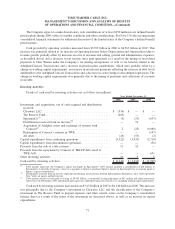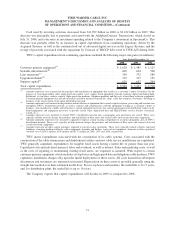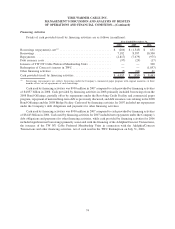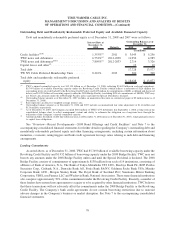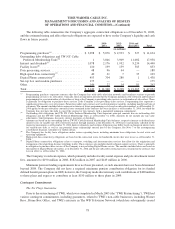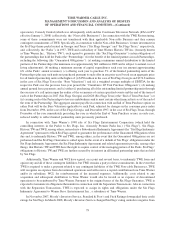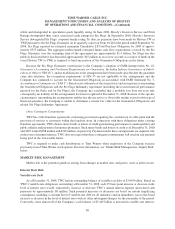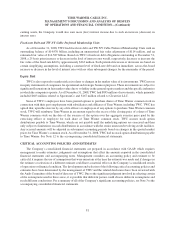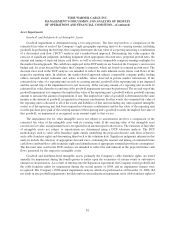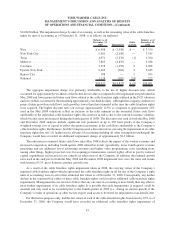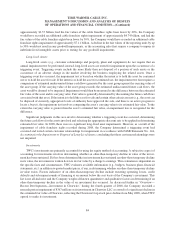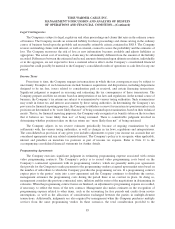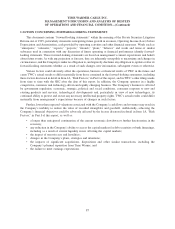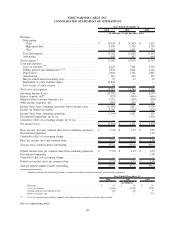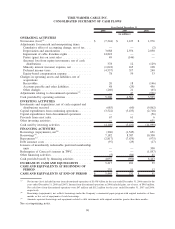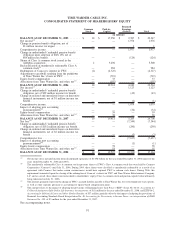Time Warner Cable 2008 Annual Report Download - page 92
Download and view the complete annual report
Please find page 92 of the 2008 Time Warner Cable annual report below. You can navigate through the pages in the report by either clicking on the pages listed below, or by using the keyword search tool below to find specific information within the annual report.Asset Impairments
Goodwill and Indefinite-lived Intangible Assets
Goodwill impairment is determined using a two-step process. The first step involves a comparison of the
estimated fair value of each of the Company’s eight geographic reporting units to its carrying amount, including
goodwill. In performing the first step, the Company determines the fair value of a reporting unit using a combination
of a discounted cash flow (“DCF”) analysis and a market-based approach. Determining fair value requires the
exercise of significant judgment, including judgment about appropriate discount rates, perpetual growth rates, the
amount and timing of expected future cash flows, as well as relevant comparable company earnings multiples for
the market-based approach. The cash flows employed in the DCF analyses are based on the Company’s most recent
budget and, for years beyond the budget, the Company’s estimates, which are based on assumed growth rates. The
discount rates used in the DCF analyses are intended to reflect the risks inherent in the future cash flows of the
respective reporting units. In addition, the market-based approach utilizes comparable company public trading
values, research analyst estimates and, where available, values observed in private market transactions. If the
estimated fair value of a reporting unit exceeds its carrying amount, goodwill of the reporting unit is not impaired
and the second step of the impairment test is not necessary. If the carrying amount of a reporting unit exceeds its
estimated fair value, then the second step of the goodwill impairment test must be performed. The second step of the
goodwill impairment test compares the implied fair value of the reporting unit’s goodwill with its goodwill carrying
amount to measure the amount of impairment, if any. The implied fair value of goodwill is determined in the same
manner as the amount of goodwill recognized in a business combination. In other words, the estimated fair value of
the reporting unit is allocated to all of the assets and liabilities of that unit (including any unrecognized intangible
assets) as if the reporting unit had been acquired in a business combination and the fair value of the reporting unit
was the purchase price paid. If the carrying amount of the reporting unit’s goodwill exceeds the implied fair value of
that goodwill, an impairment is recognized in an amount equal to that excess.
The impairment test for other intangible assets not subject to amortization involves a comparison of the
estimated fair value of the intangible asset with its carrying value. If the carrying value of the intangible asset
exceeds its fair value, an impairment loss is recognized in an amount equal to that excess. The estimates of fair value
of intangible assets not subject to amortization are determined using a DCF valuation analysis. The DCF
methodology used to value cable franchise rights entails identifying the projected discrete cash flows related to
such cable franchise rights and discounting them back to the valuation date. Significant judgments inherent in this
analysis include the selection of appropriate discount rates, estimating the amount and timing of estimated future
cash flows attributable to cable franchise rights and identification of appropriate terminal growth rate assumptions.
The discount rates used in the DCF analyses are intended to reflect the risk inherent in the projected future cash
flows generated by the respective intangible assets.
Goodwill and indefinite-lived intangible assets, primarily the Company’s cable franchise rights, are tested
annually for impairment during the fourth quarter or earlier upon the occurrence of certain events or substantive
changes in circumstances. As a result of entering into the Separation Agreement, the Company tested goodwill and
the cable franchise rights for impairment during the second quarter of 2008, and no impairment charges were
recognized. The Company’s 2008 annual impairment analysis, which was performed as of December 31, 2008, did
not result in any goodwill impairments, but did result in a noncash pretax impairment on its cable franchise rights of
82
TIME WARNER CABLE INC.
MANAGEMENT’S DISCUSSION AND ANALYSIS OF RESULTS
OF OPERATIONS AND FINANCIAL CONDITION—(Continued)


